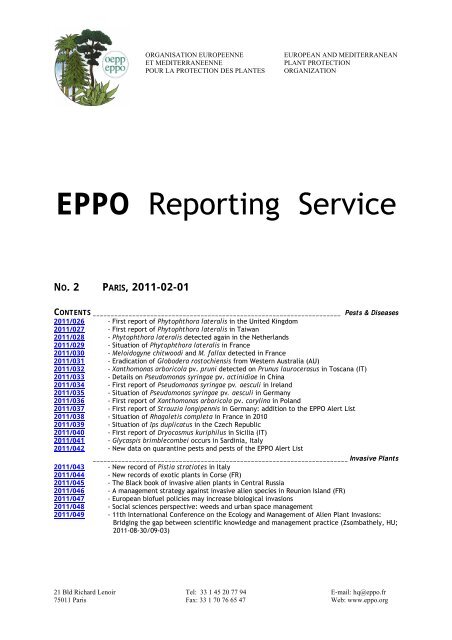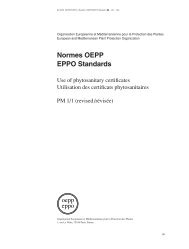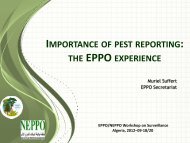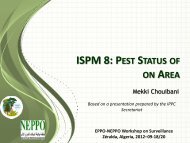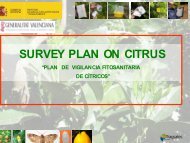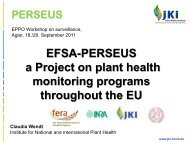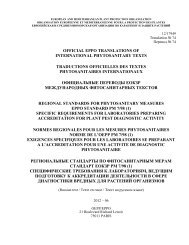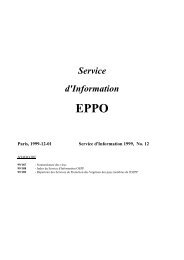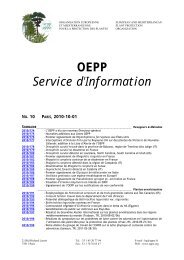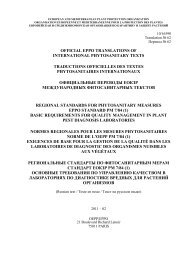EPPO Reporting Service - Lists of EPPO Standards - European and ...
EPPO Reporting Service - Lists of EPPO Standards - European and ...
EPPO Reporting Service - Lists of EPPO Standards - European and ...
Create successful ePaper yourself
Turn your PDF publications into a flip-book with our unique Google optimized e-Paper software.
21 Bld Richard Lenoir<br />
75011 Paris<br />
ORGANISATION EUROPEENNE<br />
ET MEDITERRANEENNE<br />
POUR LA PROTECTION DES PLANTES<br />
Tel: 33 1 45 20 77 94<br />
Fax: 33 1 70 76 65 47<br />
EUROPEAN AND MEDITERRANEAN<br />
PLANT PROTECTION<br />
ORGANIZATION<br />
<strong>EPPO</strong> <strong>Reporting</strong> <strong>Service</strong><br />
NO. 2 PARIS, 2011-02-01<br />
CONTENTS _____________________________________________________________________ Pests & Diseases<br />
2011/026 - First report <strong>of</strong> Phytophthora lateralis in the United Kingdom<br />
2011/027 - First report <strong>of</strong> Phytophthora lateralis in Taiwan<br />
2011/028 - Phytophthora lateralis detected again in the Netherl<strong>and</strong>s<br />
2011/029 - Situation <strong>of</strong> Phytophthora lateralis in France<br />
2011/030 - Meloidogyne chitwoodi <strong>and</strong> M. fallax detected in France<br />
2011/031 - Eradication <strong>of</strong> Globodera rostochiensis from Western Australia (AU)<br />
2011/032 - Xanthomonas arboricola pv. pruni detected on Prunus laurocerasus in Toscana (IT)<br />
2011/033 - Details on Pseudomonas syringae pv. actinidiae in China<br />
2011/034 - First report <strong>of</strong> Pseudomonas syringae pv. aesculi in Irel<strong>and</strong><br />
2011/035 - Situation <strong>of</strong> Pseudomonas syringae pv. aesculi in Germany<br />
2011/036 - First report <strong>of</strong> Xanthomonas arboricola pv. corylina in Pol<strong>and</strong><br />
2011/037 - First report <strong>of</strong> Strauzia longipennis in Germany: addition to the <strong>EPPO</strong> Alert List<br />
2011/038 - Situation <strong>of</strong> Rhagoletis completa in France in 2010<br />
2011/039 - Situation <strong>of</strong> Ips duplicatus in the Czech Republic<br />
2011/040 - First report <strong>of</strong> Dryocosmus kuriphilus in Sicilia (IT)<br />
2011/041 - Glycaspis brimblecombei occurs in Sardinia, Italy<br />
2011/042 - New data on quarantine pests <strong>and</strong> pests <strong>of</strong> the <strong>EPPO</strong> Alert List<br />
CONTENTS _______________________________________________________________________Invasive Plants<br />
2011/043 - New record <strong>of</strong> Pistia stratiotes in Italy<br />
2011/044 - New records <strong>of</strong> exotic plants in Corse (FR)<br />
2011/045 - The Black book <strong>of</strong> invasive alien plants in Central Russia<br />
2011/046 - A management strategy against invasive alien species in Reunion Isl<strong>and</strong> (FR)<br />
2011/047 - <strong>European</strong> bi<strong>of</strong>uel policies may increase biological invasions<br />
2011/048 - Social sciences perspective: weeds <strong>and</strong> urban space management<br />
2011/049 - 11th International Conference on the Ecology <strong>and</strong> Management <strong>of</strong> Alien Plant Invasions:<br />
Bridging the gap between scientific knowledge <strong>and</strong> management practice (Zsombathely, HU;<br />
2011-08-30/09-03)<br />
E-mail: hq@eppo.fr<br />
Web: www.eppo.org
<strong>EPPO</strong> <strong>Reporting</strong> <strong>Service</strong> – Pests & Diseases<br />
2011/026 First report <strong>of</strong> Phytophthora lateralis in the United Kingdom<br />
The NPPO <strong>of</strong> the United Kindgom recently informed the <strong>EPPO</strong> Secretariat <strong>of</strong> the first record<br />
<strong>of</strong> Phytophthora lateralis (<strong>EPPO</strong> A1 List) in Scotl<strong>and</strong>. In October 2010, dieback <strong>and</strong><br />
mortality <strong>of</strong> Chamaecyparis lawsoniana trees was noticed at the Balloch Castle Country<br />
Park. This park is an important historical site located within the Loch Lomond <strong>and</strong><br />
Trossachs National Park. Affected trees were predominantly mature (approximately 70-80<br />
year old) <strong>and</strong> showed symptoms which varied from foliage dieback <strong>of</strong> discrete patches <strong>of</strong><br />
the crown to mortality. Some <strong>of</strong> the declining Chamaecyparis trees were also showing resin<br />
bleeding on the stems <strong>and</strong> branches, which apparently originated at branch junctions or<br />
wounds. Root <strong>and</strong> stem samples were taken from 4 trees <strong>and</strong> tested. Laboratory tests<br />
(lateral flow device for Phytophthora spp., PCR <strong>and</strong> sequencing, morphology) confirmed<br />
the presence <strong>of</strong> P. lateralis.<br />
During winter, further investigations on the site were hampered by bad weather conditions<br />
(heavy snow). However, by February 2011 a total <strong>of</strong> 90 symptomatic, including 10<br />
confirmed positively by laboratory tests, infected C. lawsoniana had been identified <strong>and</strong><br />
these were all felled <strong>and</strong> destroyed by burning by 23 February. A single C. lawsoniana was<br />
confirmed as infected by P. ramorum (<strong>EPPO</strong> Alert List), only the second specimen <strong>of</strong> this<br />
species found infected with P. ramorum in the UK. A Rhododendron plant was found<br />
positive for P. ramorum <strong>and</strong> has been destroyed. P. cinnamomi was also found infecting<br />
Taxus baccata on the site. These infected plants have also been voluntarily destroyed.<br />
Investigations are continuing at the site <strong>and</strong> surveys <strong>of</strong> all C. lawsoniana within 3 km <strong>of</strong> the<br />
park will be carried out in the spring, in order to determine future management measures.<br />
For the moment, it has not been possible to identify the source <strong>of</strong> introduction <strong>of</strong> P.<br />
lateralis into Scotl<strong>and</strong> but it is suspected that the pathogen may have been present in this<br />
park for 5 to 10 years. Precautions are being taken to prevent any further spread <strong>of</strong> the<br />
pathogen (i.e. prohibition to move plant material from the infected site including<br />
composted material, disinfection <strong>of</strong> all machinery <strong>and</strong> equipment used for tree<br />
destruction, warning notices for visitors <strong>and</strong> disinfectant foot mats at all exit points <strong>of</strong> the<br />
park).<br />
The pest status <strong>of</strong> Phytophthora lateralis in the United Kingdom is <strong>of</strong>ficially declared as:<br />
Present, under eradication.<br />
Source: NPPO <strong>of</strong> the United Kingdom (2011-03).<br />
Additional key words: new record Computer codes: PHYTLA, GB<br />
2011/027 First report <strong>of</strong> Phytophthora lateralis in Taiwan<br />
Studies were conducted in Taiwanese forests to detect the presence <strong>of</strong> unknown<br />
Phytophthora species or invasive species such as P. ramorum (<strong>EPPO</strong> Alert List) or P.<br />
lateralis (<strong>EPPO</strong> A1 List). In 2008, soil samples were collected in an old cypress st<strong>and</strong><br />
(Chamaecyparis obtusa var. formosana) in the Ma-Kau ecological park in North-Eastern<br />
Taiwan. Collected samples were subject to Phytophthora baiting procedures at 18°C.<br />
Several isolates <strong>of</strong> Phytophthora lateralis were identified in one soil sample which had<br />
been obtained from water running through a cedar st<strong>and</strong>. This is the first time that P.<br />
lateralis is recorded from Taiwan. It is hypothetized that Asia (in particular Japan, Taiwan<br />
<strong>and</strong> Yunnan) is the area <strong>of</strong> origin for P. lateralis. The authors concluded that further<br />
surveys <strong>of</strong> P. lateralis in Taiwanese Chamaecyparis st<strong>and</strong>s are needed, as well as<br />
comparative studies between isolates from different continents (Asia, Europe <strong>and</strong> North<br />
America).<br />
2
<strong>EPPO</strong> <strong>Reporting</strong> <strong>Service</strong> – Pests & Diseases<br />
Source: Brasier CM, Vettraino AM, Chang TT, Vannini A (2010) Phytophthora lateralis<br />
discovered in an old growth Chamaecyparis forest in Taiwan. Plant Pathology 59(4),<br />
595-603.<br />
Additional key words: new record Computer codes: PHYTLA, TW<br />
2011/028 Phytophthora lateralis detected again in the Netherl<strong>and</strong>s<br />
In 2005, Phytophthora lateralis (<strong>EPPO</strong> A1 List) was found for the first time in the<br />
Netherl<strong>and</strong>s in the province Drenthe on Chamaecyparis lawsoniana. All C. lawsoniana<br />
plants in the nursery concerned were destroyed. Subsequent annual surveys on P. lateralis<br />
were focussed on this nursery <strong>and</strong> its vicinity <strong>and</strong> confirmed the absence <strong>of</strong> the disease.<br />
However, in 2010 P. lateralis was detected again on C. lawsoniana in a nursery located in<br />
Almedo (province <strong>of</strong> Overrijssel). No link could be established between these two findings<br />
(the two nurseries are 85 km apart).<br />
In Almedo, the infected plants were found in a plot <strong>of</strong> 400 m² in which approximately 2000<br />
Chamaecyparis plants were grown. During a field inspection, some plants showing brown<br />
discoloration at the stem base <strong>and</strong> general decline were noticed. The pathogen was<br />
isolated on agar medium <strong>and</strong> PCR testing confirmed the presence <strong>of</strong> P. lateralis. The<br />
possible sources <strong>of</strong> this infection have been investigated but could not be determined.<br />
Imports <strong>of</strong> Chamaecyparis lawsoniana from outside Europe are prohibited, <strong>and</strong> there was<br />
no evidence that planting material originally produced by another Dutch nursery was the<br />
source <strong>of</strong> infection. Although it could not be excluded that infected soil adjacent to roots<br />
<strong>of</strong> non-host plants might have been a pathway, nothing could confirm this hypothesis.<br />
The infected area (approximately 100 m²) was delimited by collecting <strong>and</strong> testing<br />
additional plant samples. All plants in the infected area, as well as those located within a<br />
buffer zone <strong>of</strong> 2 m radius will be destroyed. Movements <strong>of</strong> the remaining Chamaecyparis<br />
plants will not be allowed until 2011-09-31 (<strong>and</strong> only after confirmation <strong>of</strong> the absence <strong>of</strong><br />
P. lateralis). Precautions will also be taken to avoid the dissemination <strong>of</strong> spores by human<br />
activities (e.g. by cleaning <strong>of</strong> machinery, equipment <strong>and</strong> shoes). Annual surveys on P.<br />
lateralis will continue in the Netherl<strong>and</strong>s.<br />
The pest status <strong>of</strong> Phytophthora lateralis in the Netherl<strong>and</strong>s is <strong>of</strong>ficially declared as:<br />
Transient, under eradication.<br />
Source: NPPO <strong>of</strong> the Netherl<strong>and</strong>s (2010-11).<br />
Additional key words: detailed record Computer codes: PHYTLA, NL<br />
2011/029 Situation <strong>of</strong> Phytophthora lateralis in France<br />
In France, Phytophthora lateralis (<strong>EPPO</strong> A1 List) had been isolated from Chamaecyparis<br />
lawsoniana on two occasions (in 1996 <strong>and</strong> in 1998). The origin <strong>of</strong> these detections could<br />
not be fully traced-back (it can be recalled that imports <strong>of</strong> C. lawsoniana from third<br />
countries are prohibited in the <strong>European</strong> Union). The disease was no longer reported until<br />
2005 when tree mortality <strong>and</strong> symptoms resembling those <strong>of</strong> P. lateralis were observed on<br />
several hedges <strong>of</strong> C. lawsoniana in Finistère department (Bretagne region, Western<br />
France). In Bretagne, C. lawsoniana trees were planted during the 1970s as windbreaks<br />
after removal <strong>of</strong> the traditional hedgerows (i.e. during the transformation <strong>of</strong> the historical<br />
low-intensity farming system into a more intensive one). Several samples were collected<br />
3
<strong>EPPO</strong> <strong>Reporting</strong> <strong>Service</strong> – Pests & Diseases<br />
<strong>and</strong> tested but P. lateralis could not be detected. Positive results confirming the presence<br />
<strong>of</strong> P. lateralis were obtained in 2009 in soil <strong>and</strong> in root samples <strong>of</strong> C. lawsoniana collected<br />
from 4 distantly separated municipalities in Finistère (L<strong>and</strong>révarzec, Lopérec, Moëlan,<br />
Scaër). Although the presence <strong>of</strong> the pathogen was only confirmed in these 4 localities, it<br />
is noted that the disease has already had a serious impact on the l<strong>and</strong>scape causing decline<br />
<strong>and</strong> mortality <strong>of</strong> several thous<strong>and</strong>s <strong>of</strong> Chamaecyparis trees over an area covering<br />
approximately 400 km².<br />
In Bretagne region, in addition to typical symptoms <strong>of</strong> P. lateralis (i.e. discoloration <strong>and</strong><br />
decline <strong>of</strong> the whole canopy associated with root <strong>and</strong> collar necrosis) the presence <strong>of</strong><br />
unusual symptoms was also noted. In two sites, dead branches with necrotic lesions were<br />
observed. The decline was localized in the middle or lower part <strong>of</strong> the canopy <strong>and</strong> seemed<br />
to be progressively spreading from the foliage towards the trunk. This type <strong>of</strong> decline<br />
could not be associated with any root or collar lesions. The observation <strong>of</strong> these aerial<br />
infections without root infections suggest that in addition to dissemination by water, soil<br />
<strong>and</strong> plants, P. lateralis might be air-dispersed (as in the case for P. ramorum).<br />
The situation <strong>of</strong> Phytophthora lateralis in France can be described as follows: Present,<br />
occurs in Bretagne region (Finistère) on Chamaecyparis lawsoniana trees planted as<br />
windbreaks, under <strong>of</strong>ficial control.<br />
Source: NPPO <strong>of</strong> France (2010-12).<br />
Piou D, Robin C (2010) Rapport sur la détection de Phytophthora lateralis en<br />
Bretagne (Finistère). INRA. Ministère de l’Alimentation de l’Agriculture et de la<br />
Pêche, 14 pp.<br />
Robin C, Piou D, Feau N, Douzon G, Schenck N, Hansen EM (2011) Root <strong>and</strong> aerial<br />
infections <strong>of</strong> Chamaecyparis lawsoniana by Phytophthora lateralis: a new threat for<br />
<strong>European</strong> countries. Forest Pathology (in press).<br />
Article first published online: doi: 10.1111/j.1439-0329.2010.00688.x<br />
Additional key words: detailed record Computer codes: PHYTLA, FR<br />
2011/030 Meloidogyne chitwoodi <strong>and</strong> M. fallax detected in France<br />
The NPPO <strong>of</strong> France recently informed the <strong>EPPO</strong> Secretariat about the detection <strong>of</strong><br />
Meloidogyne chitwoodi <strong>and</strong> M. fallax (both <strong>EPPO</strong> A2 List) on its territory. In 2008, M.<br />
chitwoodi <strong>and</strong> M. fallax were detected in Picardie region on scorzonera (Scorzonera<br />
hispanica) <strong>and</strong> ware potatoes (Solanum tuberosum). Surveys on vegetable crops carried out<br />
in 2009 detected another outbreak <strong>of</strong> M. chitwoodi <strong>and</strong> M. fallax in Bretagne on glasshouse<br />
vegetables (tomatoes <strong>and</strong> lettuce). It is suspected that these outbreaks resulted from the<br />
import <strong>of</strong> infested young plants from countries where the nematodes occur.<br />
The situation <strong>of</strong> both Meloidogyne chitwoodi <strong>and</strong> M. fallax in France can be described as<br />
follows: Present, detected in 2008 in Picardie (on scorzonera <strong>and</strong> ware potatoes) <strong>and</strong><br />
in 2009 in Bretagne (on glasshouse vegetables).<br />
Source: NPPO <strong>of</strong> France (2010-11).<br />
Additional key words: detailed records Computer codes: MELGCH, MELGFA, FR<br />
4
<strong>EPPO</strong> <strong>Reporting</strong> <strong>Service</strong> – Pests & Diseases<br />
2011/031 Eradication <strong>of</strong> Globodera rostochiensis from Western Australia (AU)<br />
In Western Australia (AU), Globodera rostochiensis (<strong>EPPO</strong> A2 List) was detected for the<br />
first time in 1986 <strong>and</strong> an eradication programme was implemented. From 1986 to 1989, G.<br />
rostochiensis was detected on 6 properties near Perth (covering approximately 15 ha). All<br />
infested sites were intensively fumigated, phytosanitary regulations were implemented to<br />
prevent any further spread, <strong>and</strong> all potato crops from Western Australia were tested (in<br />
total more than 31 000 tests were performed). Since 1989, G. rostochiensis has not been<br />
detected in Western Australia. On the 13 th <strong>of</strong> September 2010 <strong>and</strong> after a 24-year<br />
eradication programme, the NPPO <strong>of</strong> Australia <strong>of</strong>ficially declared that the pest has been<br />
eradicated from Western Australia.<br />
The pest status <strong>of</strong> Globodera rostochiensis in Western Australia is <strong>of</strong>ficially declared as:<br />
Absent.<br />
Source: INTERNET (last accessed in 2011-02)<br />
IPPC website. Pest reports (AUS-39/1) Australia. Eradication <strong>of</strong> potato cyst<br />
nematode (PCN) from Western Australia. https://www.ippc.int/<br />
Additional key words: eradication Computer codes: HETDRO, AU<br />
2011/032 Xanthomonas arboricola pv. pruni detected on Prunus laurocerasus in<br />
Toscana (IT)<br />
The NPPO <strong>of</strong> Italy recently informed the <strong>EPPO</strong> Secretariat <strong>of</strong> the detection <strong>of</strong> Xanthomonas<br />
arboricola pv. pruni (<strong>EPPO</strong> A2 List) on Prunus laurocerasus, in Toscana region. The<br />
bacterium was detected in a nursery in the province <strong>of</strong> Pistoia. All infected plants were<br />
immediately destroyed <strong>and</strong> surveys in the affected area were intensified. It can be<br />
recalled that X. arboricola pv. pruni had already been detected on this ornamental plant<br />
species in the Netherl<strong>and</strong>s (<strong>EPPO</strong> RS 2009/178).<br />
Source: NPPO <strong>of</strong> Italy (2010-11).<br />
Additional key words: detailed record, host plant Computer codes: XANTPR, IT<br />
2011/033 Details on Pseudomonas syringae pv. actinidiae in China<br />
The following details on the distribution <strong>of</strong> Pseudomonas syringae pv. actinidiae in China<br />
could be found in abstracts <strong>of</strong> Chinese publications on the Internet.<br />
Anhui province: bacterial canker <strong>of</strong> kiwifruit was first observed in 1999 in the district <strong>of</strong><br />
Yuexi, <strong>and</strong> since 1991 outbreaks have been reported (Cheng et al., 1995). It was observed<br />
that the kiwifruit bacterial canker was more severe in orchards at high elevation (above<br />
750 m altitude), <strong>and</strong> on south facing slopes (Li et al., 2001).<br />
Sichuan province: bacterial canker appeared in 1989 in the district <strong>of</strong> Cangxi <strong>and</strong> has since<br />
become the most destructive kiwifruit disease in the region (Wang et al., 1992).<br />
5
<strong>EPPO</strong> <strong>Reporting</strong> <strong>Service</strong> – Pests & Diseases<br />
Shaanxi province: bacterial canker appeared in the Chang’an (a district <strong>of</strong> Xi’an) in 1990<br />
<strong>and</strong> since then it has become the most destructive disease in the region (Liang et al.,<br />
2000; Shen et al., 2009).<br />
Source: Cheng H, Li Y, Wan S, Zhang J, Ping Q, Li G, Xing J (1995) Pathogenic identification<br />
<strong>of</strong> kiwifruit bacterial canker in Anhui. Journal <strong>of</strong> Anhui University, unpaginated.<br />
http://en.cnki.com.cn/Article_en/CJFDTOTAL-ANHU503.006.htm<br />
Li Y, Cheng H, Fang S, Qian Z (2001) Ecological factors affecting prevalence <strong>of</strong><br />
kiwifruit bacterial canker <strong>and</strong> bacteriostatic action <strong>of</strong> bacteriocides on Pseudomonas<br />
syringae pv. actinidae. Chinese journal <strong>of</strong> Applied Ecology, unpaginated.<br />
http://en.cnki.com.cn/Article_en/CJFDTOTAL-YYSB200103012.htm<br />
Liang Y, Zhang X, Tian C, Gao A, Wang P (2000) Pathogenic identification <strong>of</strong> kiwifruit<br />
bacterial canker in Shaanxi. Journal <strong>of</strong> Northwest Forestry College, unpaginated.<br />
http://en.cnki.com.cn/Article_en/CJFDTOTAL-XBLX200001006.htm<br />
Shen Z, Huang L, Kang Z (2009) The investigation <strong>of</strong> kiwifruit bacterial canker in<br />
Guanzhong zone <strong>of</strong> Shaanxi province. Acta Agriculturae Boreali-Occidentalis Sinica,<br />
unpaginated.<br />
http://en.cnki.com.cn/Article_en/CJFDTOTAL-XBNX200901043.htm<br />
Wang Z, Tang X, Liu S (1992) Identification <strong>of</strong> the pathogenic bacterium for bacterial<br />
canker on Actinidia in Sichuan. Journal <strong>of</strong> Southwest Agricultural University,<br />
unpaginated.<br />
http://en.cnki.com.cn/Article_en/CJFDTOTAL-XNND199206007.htm<br />
Additional key words: detailed record Computer codes: PSDMAK, CN<br />
2011/034 First report <strong>of</strong> Pseudomonas syringae pv. aesculi in Irel<strong>and</strong><br />
The NPPO <strong>of</strong> Irel<strong>and</strong> recently informed the <strong>EPPO</strong> Secretariat about the presence <strong>of</strong><br />
Pseudomonas syringae pv. aesculi (<strong>EPPO</strong> Alert List) on its territory. The bacterium was<br />
detected on horse chestnut trees (Aesculus hippocastanum) in a public park (Phoenix Park)<br />
in Dublin. In this park, horse chestnut trees account for 9% <strong>of</strong> the tree cover (1,800 trees),<br />
the majority <strong>of</strong> which are mature trees. The park management observed a decline in the<br />
health <strong>of</strong> a small portion <strong>of</strong> these trees, <strong>and</strong> the presence <strong>of</strong> P. syringae pv. aesculi was<br />
confirmed. In order to prevent the spread <strong>of</strong> the horse chestnut bleeding canker, best<br />
practice guidelines have been put into place for the removal <strong>and</strong> burial <strong>of</strong> the diseased<br />
trees. A survey <strong>of</strong> the entire horse chestnut population in the park is being undertaken to<br />
assess the number <strong>of</strong> affected trees <strong>and</strong> the extent <strong>of</strong> the symptoms on individual trees.<br />
The situation <strong>of</strong> Pseudomonas syringae pv. aesculi in Irel<strong>and</strong> can be described as follows:<br />
Present, reported in 2010 in a public park in Dublin.<br />
Source: NPPO <strong>of</strong> Irel<strong>and</strong> (2010-09).<br />
Additional key words: new record Computer codes: PSDMAX, IE<br />
6
<strong>EPPO</strong> <strong>Reporting</strong> <strong>Service</strong> – Pests & Diseases<br />
2011/035 Situation <strong>of</strong> Pseudomonas syringae pv. aesculi in Germany<br />
As reported in <strong>EPPO</strong> RS 2009/117, the presence <strong>of</strong> Pseudomonas syringae pv. aesculi (<strong>EPPO</strong><br />
Alert List) in Germany was confirmed in 2008 in one horse chestnut (Aesculus<br />
hippocastanum) tree in Hamburg. The NPPO <strong>of</strong> Germany recently informed the <strong>EPPO</strong><br />
Secretariat that the disease has also been detected in Sachsen. Six horse chestnut trees<br />
that had been planted in 2008 showed bleeding <strong>and</strong> bark necrosis. One <strong>of</strong> the trees has<br />
been destroyed for diagnostic purposes, <strong>and</strong> the remaining five are under supervision. The<br />
NPPO <strong>of</strong> Germany explained that the pest status <strong>of</strong> P. syringae pv. aesculi in Germany was<br />
difficult to describe because the diagnostics for this disease is complex <strong>and</strong> the presence<br />
<strong>of</strong> the bacterium could only be confirmed in a few cases. Nevertheless, based on this<br />
uncertain data, the pest status <strong>of</strong> Pseudomonas syringae pv. aesculi in Germany is<br />
<strong>of</strong>ficially declared as: Present, verified only in parts <strong>of</strong> the area / single cases.<br />
Source: NPPO <strong>of</strong> Germany (2011-02).<br />
Additional key words: detailed record Computer codes: PSDMAX, DE<br />
2011/036 First report <strong>of</strong> Xanthomonas arboricola pv. corylina in Pol<strong>and</strong><br />
In Pol<strong>and</strong>, hazelnut (Corylus avellana) has been traditionally grown in gardens <strong>and</strong> small<br />
family orchards but recently its commercial production has become more widespread. In<br />
2007, unusual symptoms were observed on different hazelnut cultivars grown in one<br />
orchard in Central Pol<strong>and</strong>. In this orchard, the majority <strong>of</strong> 15-year-old trees showed<br />
angular necrotic lesions on leaves <strong>and</strong> involucres (husks), <strong>and</strong> twig cankers. In 2009, similar<br />
symptoms were observed in this orchard, as well as in a young hazelnut orchard located<br />
nearby where almost all trees (4-year-old trees, covering 1 ha) were affected. Bacterial<br />
colonies were consistently isolated from diseased trees <strong>and</strong> further analysis following the<br />
<strong>EPPO</strong> St<strong>and</strong>ard PM7/22 confirmed the presence <strong>of</strong> Xanthomonas arboricola pv. corylina<br />
(<strong>EPPO</strong> A2 List). The pathogenicity <strong>of</strong> the Polish bacterial isolates was tested in glasshouse<br />
experiments <strong>and</strong> X. arboricola pv. corylina could be re-isolated from symptomatic tissues<br />
<strong>of</strong> inoculated plants, thus completing Koch’s postulates. This is the first time that X.<br />
arboricola pv. corylina has been detected in Pol<strong>and</strong>. The authors noted that an extensive<br />
survey carried out in the early 2000s had not detected the bacterium in the Polish hazelnut<br />
plantations, which suggests that its introduction in Pol<strong>and</strong> is recent.<br />
The situation <strong>of</strong> Xanthomonas arboricola pv. corylina in Pol<strong>and</strong> can be described as:<br />
Present, first detected in 2007 in Central Pol<strong>and</strong>, in a limited number <strong>of</strong> orchards.<br />
Source: Pulawska J, Kaluzna M, Kolodziejska A, Sobiczewski P (2010) Identification <strong>and</strong><br />
characterization <strong>of</strong> Xanthomonas arboricola pv. corylina causing bacterial blight <strong>of</strong><br />
hazelnut: a new disease in Pol<strong>and</strong>. Journal <strong>of</strong> Plant Pathology 92(3), 803-806.<br />
<strong>EPPO</strong> (2004) <strong>EPPO</strong> <strong>St<strong>and</strong>ards</strong> PM7/22. Diagnostic protocols for regulated pests:<br />
Xanthomonas arboricola pv. corylina. Bulletin OEPP/<strong>EPPO</strong> Bulletin 34, 155–157.<br />
http://archives.eppo.org/<strong>EPPO</strong><strong>St<strong>and</strong>ards</strong>/PM7_DIAGNOS/pm7-22(1).pdf<br />
Additional key words: new record Computer codes: XANTCY, PL<br />
7
<strong>EPPO</strong> <strong>Reporting</strong> <strong>Service</strong> – Pests & Diseases<br />
2011/037 First report <strong>of</strong> Strauzia longipennis in Germany: addition to the <strong>EPPO</strong><br />
Alert List<br />
The NPPO <strong>of</strong> Germany recently informed the <strong>EPPO</strong> Secretariat <strong>of</strong> the first record <strong>of</strong><br />
Strauzia longipennis (Diptera: Tephritidae – sunflower maggot) on its territory, which also<br />
represents a first record for Europe. In June 2010, S. longipennis was found on a single<br />
sunflower plant (Helianthus annuus) in a private garden in Berlin (locality <strong>of</strong> Johannisthal<br />
in the Berlin borough <strong>of</strong> Treptow-Köpenick). This sunflower plant did not show external<br />
symptoms, but two female flies were observed walking on the leaves <strong>and</strong> ovipositing in the<br />
stem. Three other findings were made in 2010 in Berlin, in the localities <strong>of</strong> Wartemberg,<br />
Lankwitz <strong>and</strong> Tempelh<strong>of</strong> (boroughs <strong>of</strong> Lichtenberg, Steglitz-Zehlendorf, Tempelh<strong>of</strong>-<br />
Schöneberg, respectively). Investigations suggested that S. longipennis has probably been<br />
present since 2008 in Berlin. The Regional Plant Protection <strong>Service</strong> will carry out a survey<br />
in 2011 at the locations where the pest has been recorded. A rapid PRA conducted by the<br />
NPPO suggested that S. longipennis could represent a medium risk for Germany. Further<br />
more, considering the importance <strong>of</strong> sunflower cultivation in the <strong>EPPO</strong> region, the German<br />
NPPO suggested that S. longipennis should be added to the <strong>EPPO</strong> Alert List.<br />
Strauzia longipennis (Diptera: Tephritidae – Sunflower maggot)<br />
Why An isolated finding <strong>of</strong> Strauzia longipennis, a North American pest <strong>of</strong> sunflowers,<br />
was reported in 2010 from Germany. Considering the importance <strong>of</strong> sunflower<br />
(Helianthus annuus) cultivation in the <strong>EPPO</strong> region, the German NPPO suggested<br />
that S. longipennis should be added to the <strong>EPPO</strong> Alert List.<br />
Where S. longipennis is a North American species which had not been reported outside<br />
its native area, so far.<br />
<strong>EPPO</strong> region: Germany (incursions detected in 2010 in Berlin).<br />
North America: Canada (Alberta, Manitoba, Ontario, <strong>and</strong> possibly other<br />
provinces), USA (Arizona, California, Colorado, Connecticut, Florida (not<br />
established), Idaho, Illinois, Indiana, Iowa, Kansas, Massachusetts, Michigan,<br />
Minnesota, Mississippi, Missouri, Montana, Nebraska, New Jersey, New Mexico,<br />
New York, North Carolina, North Dakota, Ohio, Oregon, Pennsylvania, South<br />
Dakota, Texas, Utah, Virginia, Wisconsin).<br />
On which plants Helianthus annuus (sunflower), <strong>and</strong> other Helianthus species such as H.<br />
maximilianii <strong>and</strong> H. tuberosus (Jerusalem artichoke). S. longipennis has also<br />
been observed on other Asteraceae (e.g. Ageratina altissima, Ambrosia trifida,<br />
Smallanthus uvedalia). S. longipennis is a morphologically variable species <strong>and</strong><br />
its taxonomy is still uncertain (several varieties have been proposed <strong>and</strong> some<br />
elevated to species rank although this is still being debated). Recent studies have<br />
suggested that S. longipennis might be a complex <strong>of</strong> host-associated populations<br />
that are in the process <strong>of</strong> divergence (incipient species).<br />
Damage Larvae <strong>of</strong> S. longipennis bore tunnels in the pith <strong>of</strong> sunflower stalks. Depending<br />
on the number <strong>of</strong> larvae, injury may vary from a short tunnel to complete<br />
destruction <strong>of</strong> the pith. Large infestations can weaken the stalk <strong>and</strong> eventually<br />
lead to plant breakage. Secondary fungal infections (e.g. Sclerotinia) can be<br />
associated with larval feeding inside the stalk. However, in the major sunflowerproducing<br />
regions <strong>of</strong> North America (North <strong>and</strong> South Dakota, Minnesota <strong>and</strong><br />
Manitoba), S. longipennis is usually considered as a minor pest. Even when high<br />
percentages <strong>of</strong> plants are infested, larval feeding is confined to the pith, which<br />
acts a supporting structure <strong>and</strong> is not critical for plant nutrition. Studies carried<br />
out in the 1950s in Manitoba (CA) in fields where a high percentage <strong>of</strong> sunflower<br />
plants were infested concluded that feeding damage caused by larvae to the pith<br />
<strong>of</strong> the sunflower stalk had no apparent affect on head diameter, seed yield <strong>and</strong><br />
quality.<br />
Adults <strong>of</strong> S. longipennis are showy yellow tephritid flies (body length around 6<br />
mm, wingspan <strong>of</strong> 13 mm) with bright green eyes. Wings have dark brown b<strong>and</strong>s<br />
8
<strong>EPPO</strong> <strong>Reporting</strong> <strong>Service</strong> – Pests & Diseases<br />
that form a fairly distinct F pattern near the wing tip. Larvae are creamy white<br />
<strong>and</strong> attain approximately 7 mm length at maturity.<br />
Pictures can be viewed on the Internet:<br />
http://www.insectimages.org/browse/subthumb.cfm?sub=7967<br />
http://bugguide.net/node/view/36888/bgimage<br />
S. longipennis has one generation per year. Female lay eggs (white, elongated, 1<br />
mm long) in the stem tissue <strong>of</strong> young plants <strong>and</strong> larvae feed in the stem pith<br />
tissue. Larvae develop though 3 instars before pupation takes place. The insect<br />
usually overwinters as larvae in plant debris in the soil, but in regions such as<br />
Manitoba <strong>and</strong> Ontario (CA), observations have shown that larvae leave the plant<br />
at the end <strong>of</strong> summer <strong>and</strong> enter the soil where they overwinter as pupae.<br />
Dissemination Adults are reported as strong fliers but no data is available on their potential for<br />
natural spread. Over long distances, sunflower plants, soil <strong>and</strong> eventually cut<br />
flowers may transport the pest. Seeds are not considered as a likely pathway.<br />
Pathway Plants for planting, cut flowers <strong>of</strong> host plant species, soil <strong>and</strong> growing medium<br />
(no data is available to evaluate the possibility that tubers <strong>of</strong> H. tuberosus with<br />
adhering soil could transport the pest).<br />
Possible risks Sunflower (Helianthus annuus) is native to the Americas. In the <strong>EPPO</strong> region, it is<br />
an economically important crop which is widely grown for agricultural purposes<br />
(oil, seeds, animal feed, bi<strong>of</strong>uel) <strong>and</strong> to a lesser extent for ornamental purposes.<br />
The cultivation <strong>of</strong> other Helianthus species, such as H. tuberosus (Jerusalem<br />
artichoke), is <strong>of</strong> much lesser economic importance. In North America, S.<br />
longipennis is usually considered as a minor pest but it may be possible that its<br />
populations are kept under economic threshold by natural enemies (e.g.<br />
parasitoids like Coptera strauziae (Hymenoptera: Diapriidae)) or insecticide<br />
treatments targeting other pests (e.g. sunflower beetle Zygogramma<br />
exclamationis (Coleoptera: Chrysomelidae), absent in Europe). Although, there<br />
are still uncertainties about the potential <strong>of</strong> damage <strong>of</strong> S. longipennis to<br />
sunflower crops in Europe (as very high populations are needed to cause stem<br />
breakage <strong>and</strong> lodging), it is desirable to avoid its spread within the <strong>EPPO</strong> region.<br />
It can be noted that in the <strong>EPPO</strong> region, sunflower crops are subject to a limited<br />
number <strong>of</strong> insect pests which usually do not require specific treatments <strong>and</strong><br />
therefore, it is highly desirable to maintain this rather favourable situation.<br />
Source(s) Allen WR, Westdal PH, Barrett CF, Askew WL (1954) Control <strong>of</strong> the sunflower maggot, Strauzia<br />
longipennis (Wied.) (Diptera: Trypetidae) with demeton. Report <strong>of</strong> the Entomological Society <strong>of</strong><br />
Ontario, 53-56 (abst.).<br />
Axen HJ, Harrison JL, Gammons JR, McNish IG, Blythe LD, Condon MA (2010) Incipient speciation in<br />
Strauzia longipennis (Diptera: Tephritidae): two sympatric mitochondrial DNA lineages in Eastern<br />
Iowa. Annals <strong>of</strong> the Entomological Society <strong>of</strong> America 103(1), 11-19.<br />
Brückner C, Korneyev SV (2010) Strauzia longipennis (Diptera: Tephritidae), an important pest <strong>of</strong><br />
sunflowers recorded for the first time in the Palaearctic Region. Ukrainska Entom<strong>of</strong>aunistyka 1(1),<br />
55-57.<br />
Charlet LD, Brewer GJ (2009) Sunflower Insect Pest Management in North America. In: Radcliffe EB,<br />
Hutchinson WD, Cancelado RE (eds). Radcliffe’s IPM World Textbook.<br />
http://ipmworld.umn.edu/chapters/charlet2.htm. University <strong>of</strong> Minnesota, St Paul (US).<br />
Charlet LD, Brewer GJ, Beregovoy VH (1992) Insect fauna <strong>of</strong> the heads <strong>and</strong> stems <strong>of</strong> native sunflowers<br />
(Asterales: Asteraceae) in Eastern North Dakota. Environmental Entomology 21(3), 493-500.<br />
Foote RH, Blanc FL, Norrbom AL (1993) H<strong>and</strong>book <strong>of</strong> the fruit flies (Diptera: Tephritidae) <strong>of</strong> America<br />
North <strong>of</strong> Mexico. Cornell University Press (US), 571 pp.<br />
Rogers CE (1988) Insects from native <strong>and</strong> cultivated sunflowers (Helianthus) in Southern latitudes <strong>of</strong><br />
the United States. Journal <strong>of</strong> Agricultural Entomology 5(4), 267-287.<br />
Steyskal GC (1986) Taxonomy <strong>of</strong> the adults <strong>of</strong> the genus Strauzia Robineau-Desvoidy ‘(Diptera,<br />
Tephriticae) Insecta Mundi 1(3), 100-117.<br />
Sutton BD, Steck GJ (2005) An annotated checklist <strong>of</strong> the Tephritidae (Diptera) <strong>of</strong> Florida. Insecta<br />
Mundi 19(4), 227-245.<br />
Westdal PH, Barrett CF (1960) Life-history <strong>and</strong> habits <strong>of</strong> the sunflower maggot, Strauzia longipennis<br />
(Wied.) (Diptera: Trypetidae), in Manitoba. Canadian Entomologist 92(7), 481-488 (abst.).<br />
Westdal PH, Barrett CF (1962) Injury by the sunflower maggot, Strauzia longipennis (Wied.) (Diptera:<br />
Trypetidae), to sunflowers in Manitoba. Canadian Journal <strong>of</strong> Plant Science 42(1), 11-14.<br />
INTERNET (last accessed in 2011-02)<br />
The Connecticut Agricultural Experiment Station. Sunflower (Helianthus). Plant health problems.<br />
http://www.ct.gov/caes/cwp/view.asp?a=2823&q=377954<br />
9
<strong>EPPO</strong> <strong>Reporting</strong> <strong>Service</strong> – Pests & Diseases<br />
North Dakota State University, Extension <strong>Service</strong>. Knodel JJ, Charlet LD, Gavloski J (2010) Integrated<br />
Pest Management <strong>of</strong> sunflower insect pests in the Northern Great Plains.<br />
http://www.ag.ndsu.edu/pubs/plantsci/pests/e1457.pdf<br />
Manitoba Agriculture, Food <strong>and</strong> Rural Initiatives. Sunflower maggots.<br />
http://www.gov.mb.ca/agriculture/crops/insects/fad41s00.html<br />
University <strong>of</strong> Guelph (CA). Paiero SM, Marshall SA, Pratt PD, Buck M (2008) The insects <strong>of</strong> Ojibway<br />
Prairie, a southern Ontario tallgrass prairie.<br />
http://www.uoguelph.ca/debu/Insects_Of_Ojibway_Species_List_2008.pdf<br />
University <strong>of</strong> Guelph (CA). Smith S, Wukasch RT (2007) Sunflower maggot. Strauzia longipennis<br />
(Diptera: Trypetidae). http://www.uoguelph.ca/pdc/Factsheets/PDFs/100SunflowerMaggot.pdf<br />
<strong>EPPO</strong> RS 2011/037<br />
Panel review date - Entry date 2011-02<br />
2011/038 Situation <strong>of</strong> Rhagoletis completa in France in 2010<br />
As reported in <strong>EPPO</strong> RS 2008/138, Rhagoletis completa (Diptera: Tephritidae – EU Annexes)<br />
was reported for the first time in South-Eastern France on walnut trees (Juglans regia) in<br />
2007. In 2009 <strong>and</strong> 2010, R. completa was also detected in South-Western France, as well as<br />
in the northern part (<strong>EPPO</strong> RS 2010/182). A national survey was conducted in 2010 to<br />
determine the extent <strong>of</strong> the pest spread. As a result, the presence <strong>of</strong> R. completa was<br />
confirmed in the following regions (<strong>and</strong> departments):<br />
South-East<br />
- Languedoc-Roussillon (Aude, Hérault, Gard)<br />
- Provence-Alpes-Côte d’Azur (Alpes de Haute Provence, Bouches du Rhône, Hautes-<br />
Alpes, Vaucluse)<br />
- Rhône-Alpes (Ardèche, Drôme, Isère, Rhône, Savoie)<br />
South-West<br />
- Aquitaine (Dordogne, Gironde, Lot-et-Garonne)<br />
- Midi-Pyrénées (Gers, Haute-Garonne, Lot, Tarn-et-Garonne, Tarn)<br />
North<br />
- Alsace (Bas-Rhin, Haut-Rhin)<br />
- Ile-de-France (Essonne, Hauts de Seine, Seine Saint Denis, Yvelines)<br />
The situation <strong>of</strong> Rhagoletis completa in France can be described as follows: Present, first<br />
found in 2007 in Rhône-Alpes; it then spread to several regions (Alsace, Aquitaine, Ile<br />
de France, Languedoc-Roussillon, Midi-Pyrénées, Provence-Alpes-Côte d’Azur, Rhône-<br />
Alpes).<br />
Source: NPPO <strong>of</strong> France (2010-12).<br />
Additional key words: detailed record Computer codes: RHAGCO, FR<br />
2011/039 Situation <strong>of</strong> Ips duplicatus in the Czech Republic<br />
Until the beginning <strong>of</strong> the 20 th century, Ips duplicatus (Curculionidae, Scolytinae - EU<br />
Annexes) occurred only in the Euro-Siberian taiga from Sweden to the Sakhalin Isl<strong>and</strong> <strong>and</strong><br />
in the Alps. During the subsequent decades the pest has exp<strong>and</strong>ed its range to Central<br />
Europe (e.g. Czech Republic, Pol<strong>and</strong>, <strong>and</strong> Slovakia). In the Czech Republic, the insect was<br />
first recorded in the 1920s <strong>and</strong> outbreaks have been reported since the 1970s in the North-<br />
East. Monitoring surveys with pheromone traps were carried out from 1997 to 2009 in state<br />
forests <strong>and</strong> showed that I. duplicatus now occurs practically across the whole territory <strong>of</strong><br />
the Czech Republic, mainly on spruce (Picea abies). The numbers <strong>of</strong> insects caught<br />
fluctuated over time (low populations were observed in 2002 <strong>and</strong> a peak was observed in<br />
10
<strong>EPPO</strong> <strong>Reporting</strong> <strong>Service</strong> – Pests & Diseases<br />
2008). Insect populations were higher in the North-Eastern <strong>and</strong> Eastern parts <strong>of</strong> the country<br />
(Northern Moravia <strong>and</strong> Silesia) where I. duplicatus was first recorded but observations<br />
showed that it is currently spreading towards the South <strong>and</strong> West. In the North-Eastern<br />
parts <strong>of</strong> Czech Republic up to 80% <strong>of</strong> the spruce trees which had been felled for sanitary<br />
reason were infested by I. duplicatus. However, it is acknowledged that several factors are<br />
involved in spruce decline, including low soil pH, nutrient deficiency, drought, infections<br />
by Armillaria ostoyae <strong>and</strong> bark beetles. In the South <strong>and</strong> West parts <strong>of</strong> the country where<br />
populations <strong>of</strong> I. duplicatus were lower, no economically significant damage was observed.<br />
The situation <strong>of</strong> Ips duplicatus in the Czech Republic can be described as follows: Present,<br />
mainly in the north-eastern <strong>and</strong> eastern parts on Picea abies but spreading towards the<br />
south <strong>and</strong> west.<br />
Source: Holuša J, Grodzki W (2008) Occurrence <strong>of</strong> Ips duplicatus (Coleoptera: Curculionidae,<br />
Scolytinae) on pines (Pinus sp.) in the Czech Republic <strong>and</strong> southern Pol<strong>and</strong> – Short<br />
Communication. Journal <strong>of</strong> Forest Science 54(5), 234–236.<br />
Holuša J, Lubojacky J, Knizek M (2010) Distribution <strong>of</strong> the double-spined spruce bark<br />
beetle in the Czech Republic: spreading in 1997-2009. Phytoparasitica 38(5), 435-<br />
443.<br />
Additional key words: detailed record Computer codes: IPSXDU, CZ<br />
2011/040 First report <strong>of</strong> Dryocosmus kuriphilus in Sicilia (IT)<br />
The NPPO <strong>of</strong> Italy recently informed the <strong>EPPO</strong> Secretariat <strong>of</strong> the first record <strong>of</strong> Dryocosmus<br />
kuriphilus (Hymenoptera: Cynipidae – <strong>EPPO</strong> A2 List) in Sicilia region. In 2010, D. kuriphilus<br />
was found in three neighbouring municipalities (Sant’ Alfio, Milo <strong>and</strong> Linguaglossa) <strong>of</strong> the<br />
province <strong>of</strong> Catania. The Regional PPO <strong>of</strong> Sicilia has launched a specific monitoring<br />
programme in order to delimit the extent <strong>of</strong> the infestation <strong>and</strong> define demarcated areas.<br />
The situation <strong>of</strong> Dryocosmus kuriphilus in Italy can be described as follows: Present, first<br />
found in 2008 near Cuneo, scattered outbreaks reported from Abruzzo, Calabria,<br />
Campania, Emilia-Romagna, Friuli-Venezia Giulia, Lazio, Liguria, Lombardia, Marche,<br />
Molise, Toscana, Trentino-Alto Adige, Piemonte, Sardegna, Sicilia, Umbria, Valle<br />
d’Aosta <strong>and</strong> Veneto; under <strong>of</strong>ficial control.<br />
Source: NPPO <strong>of</strong> Italy (2010-10).<br />
Additional key words: detailed record Computer codes: DRYCKU, IT<br />
11
<strong>EPPO</strong> <strong>Reporting</strong> <strong>Service</strong> – Pests & Diseases<br />
2011/041 Glycaspis brimblecombei occurs in Sardinia, Italy<br />
In Italy, Glycaspis brimblecombei (Hemiptera: Psyllidae – formerly <strong>EPPO</strong> Alert List) was<br />
detected for the first time in March 2010 on the foliage <strong>of</strong> Eucalyptus camaldulensis trees<br />
in several provinces <strong>of</strong> Campania (see <strong>EPPO</strong> RS 2010/186 <strong>and</strong> article from Laudonia &<br />
Garonna on the <strong>EPPO</strong> website). The NPPO <strong>of</strong> Italy recently informed the <strong>EPPO</strong> Secretariat<br />
that the pest has also been found in Sardinia on trees <strong>of</strong> E. camaldulensis. Surveys are<br />
being carried out in Sardinia to delimit the extent <strong>of</strong> the infestation.<br />
The situation <strong>of</strong> Glycaspis brimblecombei in Italy can be described as follows: Present,<br />
found in Campania <strong>and</strong> Sardinia on Eucalyptus camaldulensis.<br />
Source: NPPO <strong>of</strong> Italy (2010-12).<br />
<strong>EPPO</strong> Website<br />
Laudonia S & Garonna AP (2011) First record <strong>of</strong> the redgum lerp psyllid, Glycaspis<br />
brimblecombei, a new exotic pest <strong>of</strong> Eucalyptus camaldulensis in Southern Italy.<br />
http://www.eppo.org/QUARANTINE/Glycaspis_brimblecombei_IT/Glycaspis_brimblecombei_IT.htm<br />
Additional key words: detailed record Computer codes: GLYSBR, IT<br />
2011/042 New data on quarantine pests <strong>and</strong> pests <strong>of</strong> the <strong>EPPO</strong> Alert List<br />
By searching through the literature, the <strong>EPPO</strong> Secretariat has extracted the following new<br />
data concerning quarantine pests <strong>and</strong> pests included on the <strong>EPPO</strong> Alert List. The situation<br />
<strong>of</strong> the pest concerned is indicated in bold, using the terms <strong>of</strong> ISPM no. 8.<br />
� New records<br />
Arabis mosaic virus (Nepovirus, ArMV - EU Annexes) was reported for the first time in Spain<br />
in 2007. ArMV was detected on grapevine in Galicia (in Val de Salnés on Rias Baixas<br />
appellation) <strong>and</strong> in Pais Vasco (in Barriobusto on appellation Rioja). In the infected<br />
vineyard in Galicia, the presence <strong>of</strong> the nematode vector, Xiphinema diversicaudatum,<br />
was detected in the soil. A preliminary survey showed that the virus incidence is low <strong>and</strong><br />
that only a minimal spread occurred. In Spain as a whole, ArMV seems to be rare <strong>and</strong><br />
associated with the Atlantic biogeographic region (Abelleira et al., 2010).<br />
Acizzia jamatonica (Hemiptera: Psyllidae – formerly <strong>EPPO</strong> Alert List) was detected for the<br />
first time in Greece. In August 2009, damage caused by this psyllid was noticed in Albizia<br />
julibrissin trees in the centre <strong>of</strong> Thessaloniki (Pásztor et al., 2010). In 2009, the presence<br />
<strong>of</strong> A. jamatonica has also been reported from Serbia (Vétek et al., 2009), <strong>and</strong> Bulgaria in<br />
the city <strong>of</strong> Nessebar (Vétek <strong>and</strong> Rédei, 2009).<br />
Cowpea mild mottle virus (Carlavirus – EU Annexes) was first found in Southern Iran<br />
(Khorestan province) during the 2006 <strong>and</strong> 2007 soybean growing seasons (Tavassoli et al.,<br />
2009). Present, first found in 2006 on soybean in Khorestan province.<br />
In Iran, almond witches’ broom disease has recently been observed in the centre <strong>and</strong> south<br />
<strong>of</strong> the country. Trees showing different symptoms (yellowing <strong>and</strong> little leaf) were also<br />
observed. Studies were conducted from 2001 to 2005 <strong>and</strong> showed that several<br />
phytoplasmas could be detected in diseased almond trees. They were closely related to<br />
‘C<strong>and</strong>idatus Phytoplasma phoenicium’ (associated with almond witches’ broom in Lebanon<br />
12
<strong>EPPO</strong> <strong>Reporting</strong> <strong>Service</strong> – Pests & Diseases<br />
– formerly <strong>EPPO</strong> Alert List), ‘Ca. P. aurantifolia’, ‘Ca. P. solani’ <strong>and</strong> ‘Ca. P. trifolii’ (Zirak<br />
et al., 2009). Present, in the centre <strong>and</strong> south.<br />
Radopholus similis (<strong>EPPO</strong> A2 List) occurs in New Caledonia (Gr<strong>and</strong>ison et al., 2009).<br />
Present, no details.<br />
Xiphinema rivesi (<strong>EPPO</strong> A2 List) occurs in Chile where it was first reported in 2002.<br />
Experiments showed that X. rivesi populations from Chile were able to transmit Tomato<br />
ringspot virus to cucumber test plants (Auger et al., 2009). Present, first found in 2002.<br />
� Detailed records<br />
Frankliniella occidentalis (Thysanoptera: Thripidae – <strong>EPPO</strong> A2 List) occurs in the Azores<br />
(Portugal). It is reported from the isl<strong>and</strong>s <strong>of</strong> Faial, Saõ Jorge <strong>and</strong> Terceira (Borges et al.,<br />
2005).<br />
The presence <strong>of</strong> Globodera pallida (<strong>EPPO</strong> A2 List) in Bulgaria was confirmed in 2006. It is<br />
the prevalent Globodera species in the Smolian region, <strong>and</strong> mixed populations with G.<br />
rostochiensis were found in the regions <strong>of</strong> Blagoevgrad, S<strong>of</strong>ia, Plovdiv, <strong>and</strong> Pazardzik<br />
(Laginova <strong>and</strong> Hristova, 2009).<br />
Halyomorpha halys (Heteroptera: Pentatomidae – <strong>EPPO</strong> Alert List) occurs in Sh<strong>and</strong>ong<br />
province, China (Yang et al., 2009).<br />
Potato purple top disease (<strong>EPPO</strong> A1 List) occurs in Montana (US). At least 7 distinct<br />
phytoplasma strains belonging to 5 different phytoplasma groups (16SrI, 16SrII, 16SrVI,<br />
16SrXVIII) have been reported to cause purple top <strong>and</strong> related symptoms in potato. In<br />
Montana, a phytoplasma belonging to 16SrIII group was detected in diseased potatoes (Lee<br />
et al., 2009).<br />
Rice stripe necrosis virus (Benyvirus, RSNV – formerly <strong>EPPO</strong> Alert List) continues to spread<br />
in Latin America due to the international trade <strong>of</strong> rice seed produced in fields<br />
contaminated with RSNV-carrying cytosori <strong>of</strong> Polymyxa graminis (fungal vector). After the<br />
severe disease outbreaks observed in the eastern plains <strong>of</strong> Columbia in 1991 (<strong>EPPO</strong> RS<br />
97/019), the virus has been detected in Ecuador, Panama <strong>and</strong> Brazil. However, no severe<br />
outbreaks have been observed in these countries (Lozano <strong>and</strong> Morales, 2009).<br />
In Turkey, two years after its first discovery in Mersin province (Mediterranean region),<br />
Rhynchophorus ferrugineus (Coleoptera: Curculionidae – <strong>EPPO</strong> A2 List) is now widely<br />
distributed in parks <strong>and</strong> gardens over most parts <strong>of</strong> the Mediterranean <strong>and</strong> Aegean regions<br />
<strong>of</strong> Turkey (Atakan et al., 2009).<br />
In August 2008, symptoms <strong>of</strong> grapevine yellows were observed in vineyards near Podgorica,<br />
in Montenegro. Laboratory analysis confirmed the presence <strong>of</strong> stolbur phytoplasma<br />
(associated with bois noir) in diseased samples. A survey showed that stolbur phytoplasma<br />
could be detected in all grapevine-growing regions, <strong>and</strong> that the disease incidence could<br />
reach 20% in some vineyards. This is the first time that bois noir is reported from<br />
Montenegro (Radonjić et al., 2009).<br />
13
<strong>EPPO</strong> <strong>Reporting</strong> <strong>Service</strong> – Pests & Diseases<br />
Xanthomonas axonopodis pv. dieffenbachiae (<strong>EPPO</strong> A2 List) was found 2006 in Zhejiang<br />
province, China. It was found in Anthurium <strong>and</strong>raeanum in a park in Hangzhou (Su et al.,<br />
2008).<br />
In Iran, Xanthomonas axonopodis pv. phaseoli (<strong>EPPO</strong> A2 List) was first reported in 2002<br />
from Markazi province. Since then, it has spread from Markazi to neighbouring provinces<br />
(e.g. Lorestan, Isfahan <strong>and</strong> Chahar-Mahaal <strong>and</strong> Bakhtiari) <strong>and</strong> it has become one <strong>of</strong> the<br />
major diseases <strong>of</strong> the common bean (Phaseolus vulgaris) (Osdaghi et al., 2009).<br />
In the 2000s, Xylella fastidiosa (<strong>EPPO</strong> A1 List) was found for the first time on blueberries<br />
(Vaccinium spp.) causing a leaf scorch disease in Oregon, USA (<strong>EPPO</strong> RS 2008/074). In May<br />
2008, similar symptoms were observed on Vaccinium corymbosum hybrids in Florida <strong>and</strong><br />
the presence <strong>of</strong> X. fastidiosa was confirmed in symptomatic samples (Harmon <strong>and</strong> Hopkins,<br />
2009).<br />
� Host plants<br />
Surveys <strong>of</strong> Impatiens walleriana <strong>and</strong> Verbena hybrids in nurseries located in Fredericton<br />
(New Brunswick, Canada) <strong>and</strong> Verbena hybrids in New Delhi (India) showed widespread<br />
infection <strong>of</strong> Citrus exocortis viroid (Pospiviroid, CEVd) in vegetatively propagated <strong>and</strong><br />
seed-grown plants. Infected plants did not show any symptoms (Singh et al., 2009).<br />
Tomato spotted wilt virus (Tospovirus, TSWV – <strong>EPPO</strong> A2 List) has been detected in Opuntia<br />
ficus-indica in Spain. Affected plants showed chlorotic mottle <strong>and</strong>/or mosaic symptoms on<br />
fruits, uneven ripening <strong>and</strong> fruit deformation (Córdoba-Sellés et al., 2010).<br />
� Taxonomy<br />
Sequencing studies have been carried out to determine the relationships between the<br />
following three viruses <strong>of</strong> Rubus spp:<br />
- Raspberry mottle virus (RMoV) a tentative closterovirus recently found in the USA;<br />
- Raspberry leaf mottle virus (RLMV) <strong>and</strong> Raspberry leaf spot virus (RLSV) which are both<br />
components <strong>of</strong> the raspberry mosaic disease observed in Europe.<br />
Results suggest that these pathogens correspond to isolates <strong>of</strong> the same virus species. It is<br />
proposed that they should all refer to Raspberry leaf mottle virus (RLMV) (McGavin <strong>and</strong><br />
MacFarlane, 2009).<br />
Source: Abelleira A, Mansilla JP, Padilla V, Hita I, Cabaleiro C, Bertolini E, Olmos A,<br />
Legorburu JF (2010) First report <strong>of</strong> Arabis mosaic virus on grapevine in Spain. Plant<br />
Disease 94(5), p 635.<br />
Atakan E, Elekçioğlu IH, Gözel U, Güneş Ç, Yüksel O (2009) First report <strong>of</strong><br />
Heterorhabditis bacteriophora (Poinar, 1975) (Nematoda: Heterorhabditidae)<br />
isolated from the red palm weevil, Rhynchophorus ferrugineus (Oliver, 1970)<br />
(Coleoptera: Curculionidae) in Turkey. Bulletin OEPP/<strong>EPPO</strong> Bulletin 39(2), 189-<br />
193.<br />
Auger J, Leal G, Magunacelaya JC, Esterio M (2009) Xiphinema rivesi from Chile<br />
transmits Tomato ringspot virus to cucumber. Plant Disease 93(9), p 971.<br />
Borges PAV, Vieira V, Dinis F, Jarroca S (2005) List <strong>of</strong> arthropods. In: Borges PAV,<br />
Cunha R, Gabriel R, Martins AF, Silva L, Vieira V (eds.) (2005) A list <strong>of</strong> the<br />
terrestrial fauna (Mollusca <strong>and</strong> Arthropoda) <strong>and</strong> flora (Bryophyta, Pteridophyta <strong>and</strong><br />
Spermatophyta) from the Azores. Direcção Regional do Ambiente <strong>and</strong> Universidade<br />
dos Açores, Horta, Angra do Heroísmo <strong>and</strong> Ponta Delgada, 318 pp.<br />
Córdoba-Sellés C, Cebrián C, Alfaro-Fernández, Herrera-Vásquez JA, Torres V, Font I<br />
(2010) Molecular detection <strong>of</strong> Tomato spotted wilt virus infecting cactus pear in<br />
Spain. Petria 20(2), p 275.<br />
14
<strong>EPPO</strong> <strong>Reporting</strong> <strong>Service</strong> – Pests & Diseases<br />
Gr<strong>and</strong>ison GS, Lebegin S, Desprez ZL (2009) Plant-parasitic nematodes on economic<br />
crops <strong>of</strong> New Caledonia. Australasian Plant Pathology 38(4), 408-410 (abst.).<br />
Harmon PF, Hopkins DL (2009) First report <strong>of</strong> bacterial leaf scorch caused by Xylella<br />
fastidiosa on Southern highbush blueberry in Florida. Plant Disease 93(11), p 1220.<br />
Laginova M, Hristova T (2009) Potato cyst nematodes (Globodera spp. in Bulgaria).<br />
Bulletin OEPP/<strong>EPPO</strong> Bulletin 39(1), p 77.<br />
Lee IM, Bottner KD, Sun M (2009) An emerging potato purple top disease associated<br />
with a new 16SrIII group phytoplasma in Montana. Plant Disease 93(9), p 970.<br />
Lozano I, Morales F (2009) Molecular characterisation <strong>of</strong> Rice stripe necrosis virus as<br />
a new species <strong>of</strong> the genus Benyvirus. <strong>European</strong> Journal <strong>of</strong> Plant Pathology 124(4),<br />
673-680.<br />
McGavin WJM, MacFarlane SA (2010) Sequence similarities between Raspberry leaf<br />
mottle virus, Raspberry leaf spot virus <strong>and</strong> the closterovirus Raspberry mottle<br />
virus. Annals <strong>of</strong> Applied Biology 156(3), 439-448.<br />
Osdaghi E, Alizadeh A, Shams-Bakhsh M, Lak MR (2009) Evaluation <strong>of</strong> common bean<br />
lines for their reaction to the common bacterial blight pathogen. Phytopathologia<br />
Mediterranea 48(3), 461-468.<br />
Pásztor B, Rédei D, Vétek G (2010) First record <strong>of</strong> Acizzia jamatonica (Kuwayama)<br />
(Hemiptera: Psyllidae) in Greece. Hellenic Plant Protection Journal 3(1), 25-27.<br />
Radonjić S, Hrnčić S, Jović J, Cvrković T, Krstić O, Krnjajić S, Toševski I (2009)<br />
Occurrence <strong>and</strong> distribution <strong>of</strong> grapevine yellows caused by stolbur phytoplasma in<br />
Montenegro. Journal <strong>of</strong> Phytopathology 157(11-12), 682-685.<br />
Singh RP, Dilworth AD, Ao X, Singh M, Baranwal VK (2009) Citrus exocortis viroid<br />
transmission through commercially-distributed seeds <strong>of</strong> Impatiens <strong>and</strong> Verbena<br />
plants. <strong>European</strong> Journal <strong>of</strong> Plant Pathology 124(4), 691-694.<br />
Su T, Rungnapha K, Luo SB, Zhao LH, Xie GL (2008) [Identification <strong>of</strong> pathogenic<br />
bacteria <strong>of</strong> new bacterial disease damaging to Anthurium <strong>and</strong>raeanum in Zhejiang<br />
Province]. Journal <strong>of</strong> Zhejiang Forestry Science <strong>and</strong> Technology 28(6), 40-42<br />
(abst.).<br />
Tavassoli M, Shahraeen N, Ghorbani S (2008) Detection <strong>and</strong> some properties <strong>of</strong><br />
Cowpea mild mottle virus isolated from soybean in Iran. Pakistan Journal <strong>of</strong><br />
Biological Sciences 11(23), 2624-2628 (abst.).<br />
Vétek G, Babič A, Pásztor HB (2009) [Acizzia jamatonica (Kuwayama) (Hemiptera:<br />
Psyllidae) - a new pest <strong>of</strong> silk tree in Serbia]. Biljni Lekar 37(6), 608-613 (in<br />
Serbian – abst.).<br />
Vétek G, Rédei D (2009) First record <strong>of</strong> Acizzia jamatonica (Hemiptera: Psyllidae) in<br />
Bulgaria. Acta Zoologica Bulgarica 61(3), 323-325.<br />
Yang ZQ, Yao YX, Qiu LF, Li ZX (2009) A new species <strong>of</strong> Trissolcus (Hymenoptera:<br />
Scelionidae) parasitizing eggs <strong>of</strong> Halyomorpha halys (Heteroptera: Pentatomidae)<br />
in China with comments on its biology. Annals <strong>of</strong> the Entomological Society <strong>of</strong><br />
America 102(1), 39-47.<br />
Zirak L, Bahar M, Ahoonmanesh A (2009) Characterization <strong>of</strong> phytoplasmas<br />
associated with almond diseases in Iran. Journal <strong>of</strong> Phytopathology 157(11-12),<br />
736-741.<br />
Additional key words: new records, detailed records,<br />
host plants<br />
Computer codes: ACIZJA, ARMV00, CEVD00, CPMMV0, FRANOC,<br />
HALYHA, HETDPA, HETDRO, PHYP10, PHYPPH, POPTW0, RADOSI,<br />
RHYCFE, RLMV00, RLSV00, RMOV00, RSNV00, XANTDF, XANTPH,<br />
XIPHRI, XYLEFA, BG, BG, BR, CA, CL, CN, CN, EC, ES, GR, IN, IR,<br />
IR, ME, NC, PA, PT, RS, TR, US<br />
15
2011/043 New record <strong>of</strong> Pistia stratiotes in Italy<br />
<strong>EPPO</strong> <strong>Reporting</strong> <strong>Service</strong> – Invasive Plants<br />
Pistia stratiotes (Araceae, <strong>EPPO</strong> Alert List) is now recorded in Italy in Campania, Emilia<br />
Romagna, Lombardia, Toscana <strong>and</strong> Veneto.<br />
In Campania, the occurrence <strong>of</strong> the species was confirmed by the Plant Protection <strong>Service</strong><br />
<strong>of</strong> the Campania region <strong>and</strong> by the Department <strong>of</strong> Botany <strong>of</strong> the Università Federico II di<br />
Napoli in November 2010, in the cities <strong>of</strong> Villa Literno (Caserta) <strong>and</strong> Giugliano in Campania<br />
(Napoli).<br />
The Assessorato all’Agricoltura, the Plant Protection <strong>Service</strong> <strong>of</strong> the Campania region <strong>and</strong><br />
the Università degli Studi di Napoli Federico II have published a leaflet presenting the<br />
species <strong>and</strong> the threats it represents. The leaflet invites the institutions in charge <strong>of</strong><br />
environmental protection as well as citizens to report any suspected occurrence <strong>of</strong> the<br />
species to the Plant Protection <strong>Service</strong> <strong>of</strong> the Campania region <strong>and</strong> to the Università degli<br />
Studi di Napoli Federico II. In addition, the Plant Protection <strong>Service</strong> <strong>of</strong> the Campania region<br />
has launched surveys to limit the spread <strong>and</strong> impacts <strong>of</strong> Pistia stratiotes.<br />
Source: Assessorato all’Agricoltura, Servizio Fitosanitario Regionale, Università degli Studi di<br />
Napoli Federico II (2010) Lattuga d’acqua. Pistia stratiotes L. Progetto Piante Aliene<br />
della Regione Campania. 6 p.<br />
http://www.agricoltura.regione.campania.it/difesa/pistia.html<br />
Contact: Dott. Raffaele Griffo, Plant Protection <strong>Service</strong> <strong>of</strong> the Campania region,<br />
Email: r.griffo@maildip.regione.campania.it<br />
Additional key words: invasive alien plants, new record Computer codes: IT, PIIST<br />
2011/044 New records <strong>of</strong> exotic plants in Corse (FR)<br />
New exotic plant species have been recorded in Corse. Some <strong>of</strong> them have exhibited an<br />
invasive behavior in some places <strong>of</strong> the world, <strong>and</strong> are listed below with their origin, status<br />
in the Global Compendium <strong>of</strong> Weeds, situation in Corse, <strong>and</strong> occurrence in the <strong>EPPO</strong> region<br />
according to the DAISIE database <strong>and</strong> <strong>EPPO</strong> records:<br />
Species <strong>and</strong> family Origin Global<br />
Compendium<br />
Arctotheca calendula<br />
(Asteraceae)<br />
Bothriochloa barbinodis<br />
(Poaceae)<br />
Chamaerops humilis<br />
(Arecaceae)<br />
Euphorbia cyparissias<br />
(Euphorbiaceae)<br />
Leontodon<br />
hispidus subsp. hispidus<br />
(Asteraceae)<br />
<strong>of</strong> Weeds*<br />
Af. AW, EW, NW,<br />
SW, W<br />
Situation in Corse Occurrence in<br />
the <strong>EPPO</strong> region<br />
Escaped from garden,<br />
naturalizing in the oriental<br />
plain.<br />
N-Am. / Several plants over 250 m<br />
transect, probably<br />
introduced accidentally.<br />
N-Af., S- W One plant observed near Cap<br />
Eur.<br />
Eurasia AW, EW, NW,<br />
SW, W<br />
Corse, subspontaneous.<br />
Large population that is in<br />
the process <strong>of</strong><br />
naturalization, near Cap<br />
Corse.<br />
Eurasia AW, EW, W Found in Col de Prato,<br />
probably introduced with<br />
agricultural material (seeds,<br />
hay, livestock, etc.)<br />
16<br />
ES, FR, IT<br />
(Sardinia, Sicily),<br />
PT (incl. Azores)<br />
FR<br />
IT, PT (Azores)<br />
DK, ES, FR, GB,<br />
IE, LV, LT, NO,<br />
SE, etc.<br />
Widespread<br />
(native)
Species <strong>and</strong> family Origin Global<br />
Compendium<br />
Physalis peruviana<br />
(Solanaceae)<br />
Soliva sessilis<br />
(Asteraceae)<br />
<strong>EPPO</strong> <strong>Reporting</strong> <strong>Service</strong> – Invasive Plants<br />
<strong>of</strong> Weeds*<br />
Situation in Corse Occurrence in<br />
the <strong>EPPO</strong> region<br />
S-Am. AW, EW, W Near a water course in the<br />
Marana plain, probably<br />
escaped from the disposal <strong>of</strong><br />
its fruits. Will probably not<br />
S-Am. AW, EW, NW,<br />
W<br />
establish.<br />
ES, GB, IT, MT,<br />
PT (Azores,<br />
Madeira)<br />
Abundant in Biguglia. FR, ES, PT (incl.<br />
Azores),<br />
* Abbreviations for the Global Compendium <strong>of</strong> Weeds column:<br />
AW: agricultural weed; EW: environmental weed; NW: noxious weed; SW: sleeper weed; W: weed<br />
In addition, Ludwigia peploides subsp. montevidensis (Onagraceae, <strong>EPPO</strong> List <strong>of</strong> Invasive<br />
Alien Plants) has been found in another site, near the golf course <strong>of</strong> Lezza where it is<br />
cultivated for ornamental purposes. The species grows in the river, <strong>and</strong> has not<br />
outcompeted the existing vegetation, probably because the water course is only<br />
temporary, not allowing the species to exhibit invasive behavior.<br />
Source: A Global Compendium <strong>of</strong> Weeds.<br />
http://www.hear.org/gcw/alpha_select_gcw.htm<br />
Delivering Invasive Alien Species Inventories for Europe (DAISIE) Database.<br />
http://www.europe-aliens.org/<br />
Jeanmonod D & Schlüssel A (Eds) (2010) Notes <strong>and</strong> contributions on Corsican flora,<br />
XXIII. C<strong>and</strong>ollea 65, 267-290.<br />
Additional key words: invasive alien plants, new records Computer codes: FR, ANOBA, AROCA, CMEHU, EPHCY, LEBHI,<br />
LUDPM, PHYPE, SOSVE<br />
2011/045 The Black book <strong>of</strong> invasive alien plants in Central Russia<br />
Russian scientists have produced a black book <strong>of</strong> invasive alien plants representing an<br />
environmental problem in Central Russia. This book describes 52 invasive alien plants that<br />
are widespread in Central Russia <strong>and</strong> considered as the most aggressive species, <strong>and</strong> 48<br />
invasive alien plants that are still <strong>of</strong> limited distribution. Information on the distribution <strong>of</strong><br />
these species, estimations <strong>of</strong> economic impacts, control methods, etc. is provided. Data<br />
was retrieved from herbarium <strong>and</strong> the literature. Distribution maps with the first years <strong>of</strong><br />
reporting <strong>of</strong> the species in Central Russia are also produced.<br />
The 52 invasive alien plants already widespread are the following:<br />
Acer negundo (Sapindaceae), Acorus calamus (Acoraceae), Amaranthus albus<br />
(Amaranthaceae), Amaranthus retr<strong>of</strong>lexus (Amaranthaceae), Ambrosia artemisiifolia<br />
(Asteraceae, <strong>EPPO</strong> List <strong>of</strong> Invasive Alien Plants), Amelanchier spicata (Rosaceae, <strong>EPPO</strong> List<br />
<strong>of</strong> IAP), Amelanchier alnifolia (Rosaceae), Anisantha tectorum (Poaceae), Aster x salignus<br />
(Asteraceae), Atriplex tatarica (Amaranthaceae), Bidens frondosa (Asteraceae, <strong>EPPO</strong> List<br />
<strong>of</strong> IAP), Cardaria draba (Brassicaceae), Conyza canadensis (Asteraceae), Crataegus<br />
monogyna (Rosaceae), Cyclachaena xanthiifolia (Asteraceae), Echinocystis lobata<br />
(Cucurbitaceae), Elaeagnus angustifolia (Elaeagnaceae), Elodea canadensis<br />
(Hydrocharitaceae), Epilobium adenocaulon (Onagraceae), Epilobium pseudorubescens<br />
17
<strong>EPPO</strong> <strong>Reporting</strong> <strong>Service</strong> – Invasive Plants<br />
(Onagraceae), Elsholtzia ciliata (Lamiaceae), Erigeron annuus (Asteraceae), Erucastrum<br />
gallicum (Brassicaceae), Euphorbia peplus (Euphorbiaceae), Festuca trachyphylla<br />
(Poaceae), Fraxinus pennsylvanica (Oleaceae), Galinsoga ciliata (Asteraceae), Galinsoga<br />
parviflora (Asteraceae), Helianthus tuberosus (Asteraceae, <strong>EPPO</strong> List <strong>of</strong> IAP), Heracleum<br />
sosnowskyi (Apiaceae, <strong>EPPO</strong> A2 List), Hippophae rhamnoides (Elaeagnaceae), Hordeum<br />
jubatum (Poaceae), Impatiens gl<strong>and</strong>ulifera (Balsaminaceae, <strong>EPPO</strong> List <strong>of</strong> IAP), Impatiens<br />
parviflora (Balsaminaceae), Juncus tenuis (Juncaceae), Lepidium densiflorum<br />
(Brassicaceae), Lupinus polyphyllus (Fabaceae, <strong>EPPO</strong> List <strong>of</strong> IAP), Matricaria discoidea<br />
(Asteraceae), Oenothera biennis (Onagraceae), Oxalis stricta (Oxalidaceae), Poa supina<br />
(Poaceae), Populus alba (Salicaceae), Puccinellia distans (Poaceae), Reynoutria x<br />
bohemica (Polygonaceae, <strong>EPPO</strong> List <strong>of</strong> IAP), Reynoutria japonica (Polygonaceae, <strong>EPPO</strong> List<br />
<strong>of</strong> IAP), Sisymbrium volgense (Brassicaceae), Senecio viscosus (Asteraceae), Sorbaria<br />
sorbifolia (Rosaceae), Solidago canadensis (Asteraceae, <strong>EPPO</strong> List <strong>of</strong> IAP), Solidago<br />
gigantea (Asteraceae, <strong>EPPO</strong> List <strong>of</strong> IAP), Symphytum caucasicum (Boraginaceae), Xanthium<br />
albinum (Asteraceae).<br />
The 48 alien plants considered as invasive which are still <strong>of</strong> limited distribution in Central<br />
Russia are the following:<br />
Acer ginnala (Sapindaceae), Adenocaulon adhaerescens (Asteraceae), Amaranthus blitoides<br />
(Amaranthaceae), Ambrosia trifida (Asteraceae), Amorpha fruticosa (Fabaceae, <strong>EPPO</strong> List<br />
<strong>of</strong> IAP), Aronia x mitchurinii (Rosaceae), Arrhenatherum elatius (Poaceae), Artemisia<br />
dubia (Asteraceae), Artemisia siversiana (Asteraceae), Asclepias syriaca (Apocynaceae),<br />
Aster novi-belgii (Asteraceae), Bellis perennis (Asteraceae), Brunnera sibirica<br />
(Boraginaceae), Calystegia sepium subsp. americanum (Convolvulaceae), Caragana<br />
arborescens (Fabaceae), Corispermum declinatum (Chenopodiaceae), Cornus alba<br />
(Cornaceae), Cotoneaster lucidus (Rosaceae), Cuscuta campestris (Convolvulaceae),<br />
Erigeron droebachensis (Asteraceae), Gaillardia aristata (Asteraceae), Galega orientalis<br />
(Fabaceae), Geum macrophyllum (Rosaceae), Juglans m<strong>and</strong>shurica (Jugl<strong>and</strong>aceae), Kochia<br />
scoparia (Amaranthaceae), Lemna minuta (Araceae), Lonicera tatarica (Caprifoliaceae),<br />
Oenothera rubricaulis (Onagraceae), Parthenocissus inserta (Vitaceae), Persicaria<br />
weyrichii (Polygonaceae), Petasites hybridus (Asteraceae), Physocarpus opulifolius<br />
(Rosaceae), Prunus virginiana (Rosaceae), Quercus rubra (Fagaceae), Ribes aureum<br />
(Grossulariaceae), Robinia pseudoacacia (Fabaceae), Rosa rugosa (Rosaceae), Rudbeckia<br />
hirta (Asteraceae), Salsola tragus (Amaranthaceae), Sambucus racemosa (Adoxaceae),<br />
Symphytum x upl<strong>and</strong>icum (Boraginaceae), Telekia speciosa (Asteraceae), Thladiantha<br />
dubia (Cucurbitaceae), Ulmus pumila (Ulmaceae), Veronica filiformis (Plantaginaceae),<br />
Veronica persica (Plantaginaceae), Vinca minor (Apocynaceae), Zizania latifolia (Poaceae).<br />
Source: Vinogradova Yu K, Maiorov S R, Khorun L V (2010) Black book <strong>of</strong> the flora <strong>of</strong> Central<br />
Russia: alien plant species in Central Russian ecosystems. GEOS Moscow (RU). 512 p.<br />
Website: www.bookblack.ru<br />
Additional key words: invasive alien plants Computer codes: RU, ABOMI, ACRGN, ACRNE, ACSCA, AMAAL,<br />
AMABL, AMARE, AMBEL, AMBTR, AMEAL, AMESP, AMHFR,<br />
ARREL, ARTDU, ARTSI, ASCCU, ASTNB, ASTSL, ATXTA, BELPE,<br />
BIDFR, BROTE, CADDR, CAGSA, CRAAR, CRWAL, CSCMO,<br />
CTTLU, CVCCA, ECNLO, ELDCA, ELHCI, ELGAN, EPHPE, EPIAC,<br />
ERIAN, ERICA, ERWGA, FESTR, FRXPE, GAGOR, GAIAR, GASCI,<br />
GASPA, GEUMA, HELTU, HERSO, HIORH, HORJU, IPAGL, IPAPA,<br />
IUGMN, IUNTE, KCHFC, KYCXA, LEMMT, LEPDE, LONTA, LUPPO,<br />
MATMT, OEOBI, OEORU, OXAST, PEDHY, PHPOP, POASU,<br />
POLCU, POLWE, POPAL, PRNVG, PRTIN, PUCDI, QUERU,<br />
REYBO, RIBAU, ROBPS, ROSRG, RUDHI, SAMRA, SASKT, SENVI,<br />
SOISO, SOOCA, SOOGI, SSYVO, SYMUP, TEKSP, THDDU, ULMPU,<br />
VERFI, VERPE, VINMI, XANRI, ZIZLA<br />
18
<strong>EPPO</strong> <strong>Reporting</strong> <strong>Service</strong> – Invasive Plants<br />
2011/046 A management strategy against invasive alien species in Reunion Isl<strong>and</strong><br />
(FR)<br />
Reunion Isl<strong>and</strong> is a French oversea Department located in the Indian Ocean. It is a<br />
biodiversity hotspot hosting primary ecosystems which represent 30% <strong>of</strong> the territory <strong>of</strong> the<br />
isl<strong>and</strong>. A National Park was created in 2007 <strong>and</strong> was registered as UNESCO World Heritage<br />
in 2010. This oceanic isl<strong>and</strong> is particularly sensitive to biological invasions. Among 2000<br />
vascular plants, 892 are native, <strong>and</strong> 133 are considered invasive.<br />
The first global strategy for the management <strong>of</strong> invasive alien species in Reunion Isl<strong>and</strong><br />
was adopted in July 2010. This strategy is composed <strong>of</strong> 4 parts:<br />
- (1) prevention <strong>of</strong> the introduction <strong>of</strong> new invasive species; this involves the development<br />
<strong>of</strong> a surveillance programme, inspections <strong>and</strong> interceptions at entry points, risk analyses,<br />
improved implementation <strong>of</strong> the legislation, establishment <strong>of</strong> “green lists” <strong>of</strong> species that<br />
can be imported <strong>and</strong> used safely, research support, development <strong>of</strong> cooperation with other<br />
countries in the Indian ocean area.<br />
- (2) active management; this includes early warning through careful monitoring at entry<br />
points, in protected areas, <strong>and</strong> in agricultural <strong>and</strong> urban areas by setting cost-benefit<br />
analyses to determine whether management is needed <strong>and</strong> by mobilizing all existing<br />
expertise (government organizations, NGOs, research institutes, etc.); rapid response<br />
through the coordination <strong>of</strong> different actions <strong>and</strong> conventions with private stakeholders,<br />
<strong>and</strong> through the setting <strong>of</strong> emergency plans for action <strong>and</strong> dedicated funds; eradication,<br />
containment <strong>and</strong> control.<br />
- (3) awareness raising, communication, education <strong>and</strong> training; such action will investigate<br />
how the public pictures invasive alien species to best-adapt communication actions.<br />
Communication actions will then be undertaken toward decision makers, sociopr<strong>of</strong>essional<br />
stakeholders <strong>and</strong> the general public.<br />
- (4) governance <strong>and</strong> promotion; a coordination structure will be established to coordinate<br />
all actions; a database will be created; monitoring <strong>of</strong> results will be undertaken as well as<br />
national <strong>and</strong> international cooperation.<br />
The implementation <strong>of</strong> this strategy is ongoing since 2010 <strong>and</strong> is planned until 2013.<br />
Source: DIREN 974, Parc National de La Réunion, Région Réunion, Conseil Général 974 & ONF<br />
(2010) Stratégie de lutte contre les espèces invasives à La Réunion. Parc National de<br />
La Réunion. 97 p.<br />
http://www.reunion.ecologie.gouv.fr/rubrique.php3?id_rubrique=360<br />
Contact: Catherine Julliot, DIREN 974<br />
Email : Catherine.JULLIOT@developpement-durable.gouv.fr<br />
Additional key words: invasive alien plants Computer codes: FR<br />
2011/047 <strong>European</strong> bi<strong>of</strong>uel policies may increase biological invasions<br />
Piero Genovesi, Chair <strong>of</strong> the World Conservation Union (IUCN) Invasive Species Specialist<br />
Group has published a report on the increased risk <strong>of</strong> biological invasions due to <strong>European</strong><br />
bi<strong>of</strong>uel policies. This report is summarized below.<br />
In order to respond to climate change by reducing CO2 emissions, the EU has recently<br />
adopted policies that encourage the expansion <strong>of</strong> non-food or non-feed crops. According to<br />
the “climate <strong>and</strong> energy package”, the <strong>European</strong> Parliament <strong>and</strong> Council require by law a<br />
20% cut in emissions <strong>of</strong> greenhouse gases by 2020, compared with the 1990 levels. Meeting<br />
19
<strong>EPPO</strong> <strong>Reporting</strong> <strong>Service</strong> – Invasive Plants<br />
these targets will require a significant change in the use <strong>of</strong> l<strong>and</strong> in Europe, which may<br />
cause both direct <strong>and</strong> indirect negative environmental effects, because <strong>of</strong> the changes in<br />
the use <strong>of</strong> semi-natural habitats, or <strong>of</strong> the overall loss <strong>of</strong> forest areas. The potential<br />
increase in invasions that bi<strong>of</strong>uel plants may cause has been scarcely considered in the<br />
<strong>European</strong> context. In fact, bi<strong>of</strong>uel crops are selected for many biological traits which are<br />
common in invasive species: adaptability to poor quality habitats, rapid growth, high seed<br />
production, resistance to pests, etc. The <strong>European</strong> Union has a political m<strong>and</strong>ate to<br />
develop a regional policy on invasive alien species that should cover the bi<strong>of</strong>uels issue. The<br />
key elements to control the introduction <strong>of</strong> bi<strong>of</strong>uel crops could be ensured by either<br />
adapting the existing legislations on plant health, by creating a new sectorial policy on<br />
bi<strong>of</strong>uels, or by integrating these aspects in a comprehensive <strong>European</strong> policy on invasive<br />
alien species. One example <strong>of</strong> a recent sectorial policy that follows similar principles to<br />
those recommended for bi<strong>of</strong>uel, is the aquaculture regulation 708/2007 <strong>of</strong> 11 June 2007.<br />
This legislation has introduced a ban on the introduction <strong>of</strong> any alien species used for<br />
aquaculture, unless a detailed risk assessment has proven that the species is at low risk <strong>of</strong><br />
becoming invasive. It is interesting to notice that this innovative approach for Europe has<br />
been applied to a sector with a significant economic value.<br />
Source: Genovesi P (2010) <strong>European</strong> bi<strong>of</strong>uel policies may increase biological invasions: the<br />
risk <strong>of</strong> inertia. Current Opinion in Environmental Sustainability 3, 1-5.<br />
Additional key words: invasive alien species, bi<strong>of</strong>uel<br />
2011/048 Social sciences perspective: weeds <strong>and</strong> urban space management<br />
The intensive use <strong>of</strong> herbicides in city parks <strong>and</strong> gardens can lead to problems <strong>of</strong> residues<br />
in city waters (above the accepted st<strong>and</strong>ards), as this has been observed for example in<br />
Bretagne in the city <strong>of</strong> Rennes (FR). Tackling this problem implies changing management<br />
techniques for green spaces, but also changing the perception that citizens have <strong>of</strong> weeds.<br />
Menozzi has therefore undertaken a sociological study on the perception <strong>of</strong> weeds in cities,<br />
which is summarized below.<br />
In Rennes (FR), in the framework <strong>of</strong> sustainable management <strong>of</strong> green areas, a project<br />
consisting <strong>of</strong> avoiding the use <strong>of</strong> phytosanitary products both in public <strong>and</strong> private spaces<br />
has been launched in 2 districts. The sociological study then consisted in showing<br />
inhabitants <strong>of</strong> these 2 districts pictures <strong>of</strong> places where spontaneous plants were present<br />
<strong>and</strong> to ask them their opinion on them. Many inhabitants were surprised that the pictures<br />
had been taken in their district <strong>and</strong> did not recognize the places. The enquiries also<br />
highlighted a lack <strong>of</strong> observation <strong>and</strong> recognition <strong>of</strong> plants. Very few <strong>of</strong> the species growing<br />
spontaneously were recognized, <strong>and</strong> plants were generally quoted under generic names<br />
such as “forget-me-not”, or “d<strong>and</strong>elion”. These species were generally designated as<br />
“weeds”, <strong>and</strong> were not considered to be in the right place in urban areas. It appeared that<br />
in the inhabitants’ perception, the city is opposed to the countryside. The presence <strong>of</strong><br />
weeds in the city therefore appears out <strong>of</strong> place to the public, while these species are<br />
tolerated in areas such as riverbeds or along peripheral roads. Pictures showing<br />
spontaneous plants growing along railways were perceived as representing hostile<br />
environments. Interviewees associated areas where herbs grew with the presence <strong>of</strong> rats<br />
or snakes. Other fears linked to the presence <strong>of</strong> these plants included insecurity, <strong>and</strong> the<br />
potential risk <strong>of</strong> these plants to hide road signs. The presence <strong>of</strong> weeds was considered to<br />
make the place dirty <strong>and</strong> neglected. These plants were perceived differently according to<br />
the age <strong>and</strong> the socio-pr<strong>of</strong>essional category <strong>of</strong> the respondents. In public <strong>and</strong> private<br />
areas, popular socio-pr<strong>of</strong>essional classes as well as elders were sensitive to the cleanness<br />
20
<strong>EPPO</strong> <strong>Reporting</strong> <strong>Service</strong> – Invasive Plants<br />
<strong>of</strong> garden <strong>and</strong> had a negative opinion on “weeds”, as they regarded them as wild (i.e.<br />
uncontrolled by man). Weeds were better accepted by younger persons <strong>and</strong> middle <strong>and</strong><br />
upper classes, who associated them with nature (as opposed to artificial), especially when<br />
these species are in flower. Although native species may be <strong>of</strong> interest for experts such as<br />
ecologists or biologists as part <strong>of</strong> “biodiversity”, this concept was not meaningful to the<br />
inhabitants. To be accepted in the city, weeds therefore need to be controlled. In<br />
addition, it appeared that the link between weeds <strong>and</strong> water pollution was not made by<br />
interviewed persons. Although these persons mentioned being concerned by environmental<br />
problems, they did not feel responsible for resolving them <strong>and</strong> placed the responsibility to<br />
other stakeholders, in particular blamed agricultural practices for water pollution.<br />
Source: Menozzi MJ (2007) “Mauvaises herbes”, qualité de l’eau et entretien des espaces.<br />
Natures Sciences Sociétés 15, 144-153<br />
Additional key words: invasive alien plants, social sciences Computer codes: FR<br />
2011/049 11 th International Conference on the Ecology <strong>and</strong> Management <strong>of</strong> Alien<br />
Plant Invasions: Bridging the gap between scientific knowledge <strong>and</strong><br />
management practice (Zsombathely, HU; 2011-08-30/09-03)<br />
The 11 th International Conference on the Ecology <strong>and</strong> Management <strong>of</strong> Alien Plant Invasions<br />
(EMAPi), to be held in Szombathely (Hungary) between the 30 th August <strong>and</strong> the 3 rd <strong>of</strong><br />
September 2011, will be dedicated to "Bridging the gap between scientific knowledge <strong>and</strong><br />
management practice". The aims <strong>of</strong> the conference are to present new results from<br />
research <strong>and</strong> to exchange information related to any aspects <strong>of</strong> plant invasions, as well as<br />
to facilitate the communication between scientists, stakeholders <strong>and</strong> practitioners working<br />
on nature conservation, l<strong>and</strong> management or any other area influenced by plant invasion.<br />
The conference will address the following topics:<br />
1. Pathways <strong>of</strong> introduction <strong>and</strong> spread <strong>of</strong> invasive species<br />
2. Biology <strong>and</strong> ecology <strong>of</strong> invasive plants<br />
3. Interaction with other trophic levels: enemies <strong>and</strong> symbiotic species<br />
4. Genetics <strong>and</strong> evolution <strong>of</strong> invasive plants<br />
5. Invasion patterns <strong>and</strong> invasibility <strong>of</strong> habitats<br />
6. Impact <strong>of</strong> plant invasions (on plant communities, on other trophic levels, <strong>and</strong> on<br />
ecosystem functions <strong>and</strong> services)<br />
7. Mapping, inventories, databases <strong>and</strong> internet resources<br />
8. Risk assessment, prioritization, policy <strong>and</strong> programs for early detection <strong>and</strong> rapid<br />
response<br />
9. Managing alien plant invasions through policy <strong>and</strong> vegetation management practices<br />
10. Restoration <strong>and</strong> rehabilitation after successful control<br />
11. Plant invasion in a changing world: relationship between plant invasion <strong>and</strong> other<br />
global change components (climate change, pollution, eutrophication <strong>and</strong> l<strong>and</strong> use change)<br />
12. Communication <strong>and</strong> outreach<br />
13. Networking <strong>and</strong> international cooperation.<br />
The call for abstracts is open until the 31 st <strong>of</strong> March.<br />
Source: EMAPI Website:<br />
http://www.emapi2011.org/modules.php?name=home&PHPSESSID=l00f6ppc7cavkbi7<br />
6a797si1h5<br />
Additional key words: Invasive alien plants, conference Computer codes: HU<br />
21


